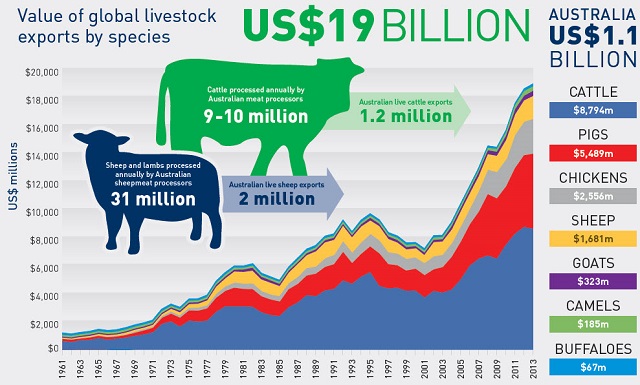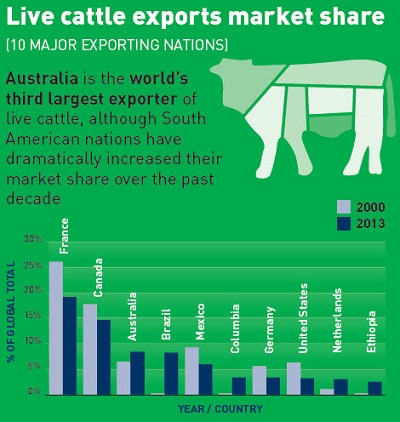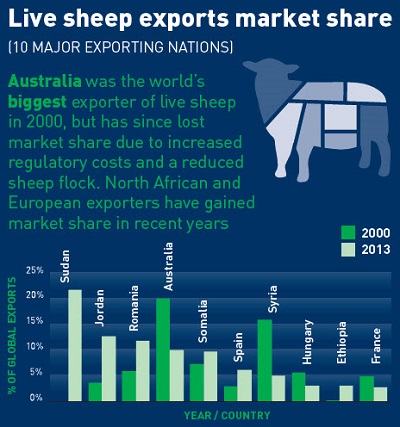Live Export Global Trade Worth $18 Billion
The trade in livestock is growing rapidly and has more than doubled in value over the past decade.
The global live export trade is now valued at over $18 billion per annum, according to a research report, Enhancing the Competitiveness of the Australian Livestock Export Industry, undertaken by the Australian Farm Institute for the Livestock Export Program, a collaborative initiative of LiveCorp and Meat & Livestock Australia.

The trade as grown, in part, due to the removal of restrictions on international agricultural trade. This has facilitated the development of integrated multi-national supply chains. In the past, agricultural exports typically went from the producer nation to the consuming nation. It is now increasingly common for trade to occur within vertically-aligned supply chains in which agricultural products from one nation are exported to undergo a second stage of production or initial processing in a second, then exported to undergo further transformation in a third nation before being exported as a consumer good to the nation of final consumption.
 These developments are occurring across the entire spectrum of agriculture, from grains through to livestock and horticulture as, in the absence of trade barriers, national comparative advantages (be they cheap land, cheap labor or low-cost energy) become more important in determining which nation is more efficient at carrying out specific activities within a supply chain. In the absence of artificial barriers to agricultural trade, nations tend to become more specialized in those areas of agricultural production or processing in which they hold national comparative advantages.
These developments are occurring across the entire spectrum of agriculture, from grains through to livestock and horticulture as, in the absence of trade barriers, national comparative advantages (be they cheap land, cheap labor or low-cost energy) become more important in determining which nation is more efficient at carrying out specific activities within a supply chain. In the absence of artificial barriers to agricultural trade, nations tend to become more specialized in those areas of agricultural production or processing in which they hold national comparative advantages.
In live export, the greatest increases in export value have been trade in cattle and pigs, although there has also been growth observed in the case of chicken and sheep. In the case of pigs and chickens, much of the trade growth has occurred between closely located nations (for example between Canada and the U.S.) whereas in the case of cattle, sheep and goats the trade has occurred between nations separated by much greater distances.
The largest national exporters of livestock are France, the Netherlands, Canada and Germany, although developing nations such as Brazil, China, Mexico and Somalia are also significant and growing exporters. The largest 12 national livestock exporters only account for a little over half the total global annual value of livestock exports, and more than 40 nations have annual livestock exports valued at over $50 million.
 The three largest importers are the U.S., Germany and Italy, but there are many nations that import livestock, with more than 50 nations importing over $50 million worth of livestock annually. Some of the largest importers are also amongst the largest exporters of livestock, highlighting the increasingly complex international supply chains that are now developing for agricultural products including livestock.
The three largest importers are the U.S., Germany and Italy, but there are many nations that import livestock, with more than 50 nations importing over $50 million worth of livestock annually. Some of the largest importers are also amongst the largest exporters of livestock, highlighting the increasingly complex international supply chains that are now developing for agricultural products including livestock.
The market is dynamic and rapidly evolving, and entails a range of different risks, including that destination markets are commonly in developing nations that do not yet have stable democratic institutions. As a consequence, they are subject to unpredictable policy changes that can dramatically impact on trade access arrangements over very short timeframes.
Australia, a leading exporter of both cattle and sheep, faces a special risk due to legislation that decrees that the welfare of Australian-originated livestock remains the responsibility of the Australian exporter, and these livestock retain their national identity to the point of slaughter, irrespective of any subsequent ownership transfer. One of the many factors affecting livestock exports is the availability of ships that are compliant with animal welfare regulations.
This legislated requirement is fundamentally at odds with established legal frameworks governing the ownership of livestock, both in Australia and internationally, and is one which is unique to Australian livestock exported for slaughter. It has not been adopted by any other of the more than one hundred livestock exporting nations.
However, Australia’s livestock export animal welfare standards place the nation in a very strong position to lead global efforts encouraging the adoption of similar standards by all livestock exporters, and efforts have already been made in this regard. Australian industry body, the Australian Livestock Exporters’ Council is committed to ensuring its industry produces positive animal welfare outcomes. More information is available here.
.jpg)
.jpg)
